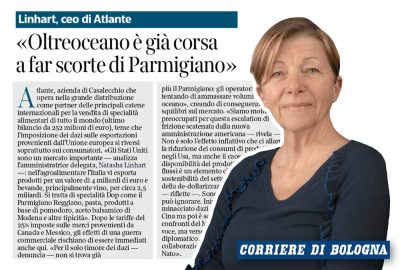Atlante
News
Ethnic Food Consumption in Italy

28 June 2023
Italians are known all over the world for their rich culinary tradition, but in recent years they have shown a growing interest in ethnic food and its various specialities.
What does ‘ethnic’ mean?
The dictionary definition of ethnic is:
“Of or relating to large groups of people classed according to common racial, national, tribal, religious, linguistic, or cultural origin or background.”
What do we mean by ‘ethnic’?
“The set of a people’s culinary traditions that is most representative both from the point of view of the products of the land and the use made of them.”
Market trends of ethnic food products
The demand for ethnic products is steadily increasing, not only in out-of-home dining, but also in our kitchens. It is estimated that between 2022-2027, the global ethnic food market will grow at an average annual rate of 12%.
Ethnic Food (Dry + Wet + Chilled) grew by 5.1% in value due to price increases.
The trend is led by the Dry + Wet categories, which account for around 60% of the turnover and have grown by 18.3% in value and 4.4% in units.
Focus on Dry + Wet cuisines: Mexican Cuisine grew particularly strongly in both DM and discount supermarkets (+20.6% and +31.1% respectively), however the increase in discount supermarket sales was led by Asian Cuisine (+32.7%)
- Asian Cuisine: Chinese Food (+27.8% in value) and Basmati Rice (+24% in value) were particularly dynamic. Both segments are developing in discount supermarkets where the assortment is based on private label (PL)
- Mexican Foods: Growth led by Mexican Foods (+24.2% in value) and Chips (+23.4%) gaining distribution points in discount supermarkets (+8)
- Other Cuisine: Increase led by couscous and other foods (+18.8% and +25.9% in value respectively), also developing in discount supermarkets (+6pts).
(Source: Nielsen data April 2023)
According to research, 75% of Italian consumers say they buy ethnic food products and prepare them at home. Of these, 50% shop in large supermarkets, while 17% shop in small, specialised stores.
What does this growth depend on?
In recent times, new groups of consumers looking for ethnic products have emerged. Several factors have contributed to this change:
- Spending more time at home and giving up restaurant outings during the pandemic led many consumers to experiment with new dishes.
- Young people and their travel-oriented attitude. Young people, who are more inclined to experiment with new flavours and have a propensity for travel, are increasingly exposed to new cuisines. This generates interest and curiosity in new dishes that they would like to continue enjoying once they return home.
- Demographic change. Italy has witnessed a significant increase in immigration in recent years, with people from different parts of the world settling permanently in the country. The increase in cultural diversity has led to a greater demand for typical foods and ingredients that reflect the traditions and culinary preferences of different ethnic communities.
In general, the tastes of Italian consumers are evolving, and in the context of an increasingly multicultural country, it is crucial to be able to satisfy everyone’s tastes and demands.
To meet these new market demands, Italian supermarkets are reorganising their shelves and expanding their product to include exotic products imported directly from their consumers’ country of origin or with products considered ‘exotic’ but adapted to serve the Italian market.
This change represents a great market opportunity, as the introduction of new products can attract new customers and increase sales.
A quick glance at today’s supermarket shelves reveals the cuisines favoured by consumers, including Chinese, Arab, Mexican, Japanese, and American cuisines.
Within these categories, it is possible to make a further distinction between cuisines that have spread because of an increase in the population of origin (such as Chinese and Arab), and those that have conquered consumer palates because they have become ‘fashionable’ (Japanese, American, and Mexican).
The favourite ethnic food of Italian consumers
Chinese cuisine is considered one of the most popular and most ‘historical’ ethnic cuisines, as Chinese immigration to Italy started as early as the 1980s. Chinese cuisine and its typical dishes have adapted over time to the taste of Italians, but it is still possible to find authentic ingredients in small, specialised shops. Among the most popular dishes are spring rolls, fried rice, noodles, and sweet and sour pork.
Arab cuisine, like Chinese cuisine, has spread to Italy thanks to the increase in the population of origin and the rise of traditional restaurants. It is a cuisine rich in flavours and aromas based on ingredients such as meat, pulses, and grains, as well as different spices. Among the most common dishes are hummus (a dip made with chickpeas, tahini, lemon juice, and garlic), falafel (fried spiced chickpea balls), and couscous with meat or vegetables.
Mexican cuisine is particularly popular as it is characterised by intense flavours and colourful, spicy dishes! Many of these, however, have been adapted to meet the preference of Italian consumers.
Among the main dishes are tacos (tortillas filled with meat, chicken, fish, or vegetables and accompanied by sauces and condiments) and Guacamole, a sauce made with avocado, tomato, onion, lime, and coriander, served with nachos or as an accompaniment for other dishes.
Various spicy sauces are very popular in Mexican cuisine and are used to give flavour to dishes.
Japanese cuisine has gained great popularity in Italy thanks to the spread of more or less ‘chic’ restaurants in major Italian cities. Today, a wide range of ingredients such as sushi rice, nori seaweed, tofu, soy sauce, and many more are available so consumers can try and replicate typical dishes at home.
American cuisine has become part of our everyday life with some typical products such as pancakes (a very well-liked breakfast option) with maple and agave syrup, which have grown in popularity since people started using them as sugar substitutes, and the much-loved peanut butter.
The European cheese market in Italy
 Another category of products that has become part of traditional Italian cuisine are cheeses, particularly European cheeses. The spread of these cheeses and the growing demand for imports can be attributed to Italians’ love of cheese, which is used to prepare many typical Italian dishes.
Another category of products that has become part of traditional Italian cuisine are cheeses, particularly European cheeses. The spread of these cheeses and the growing demand for imports can be attributed to Italians’ love of cheese, which is used to prepare many typical Italian dishes.
Among the most popular European cheeses in Italy are:
English cheeses such as Cheddar (a hard cheese with a rich flavour. It is one of the most consumed cheeses in the world and is also produced in other European countries) and Stilton, a traditional British semi-hard PDO cheese produced in the Stilton region of the UK.
French cheeses such as Brie (a soft cheese with a flowery rind that is mainly produced in the Île-de-France region and is known for its buttery texture and mild flavour) and Roquefort (a blue-veined cheese made from sheep’s milk matured in the caves of Roquefort-sur-Soulzon and famous for its strong and distinctive flavour).
Dutch cheeses such as Edam (a semi-hard cheese with a characteristic round shape and a reddish rind. It has a light, sweet flavour and is often used for snacks or as a table cheese).
The Italian market offers growth opportunities for ethnic food
Italians are known the world over for their culinary tradition, but in recent years their tastes have evolved, intrigued by the new flavours introduced by the different cultures that have crept into the country.
This inclination to experiment with new cuisines can be observed not only in the increasing number of ethnic restaurants opening every year, even outside the major cities, but also in the changes many supermarkets are making in terms of shelf space and product variety.
Therefore, it will be crucial for Italian companies to understand how to capitalize on these emerging market trends and transform them into opportunities for growth.





